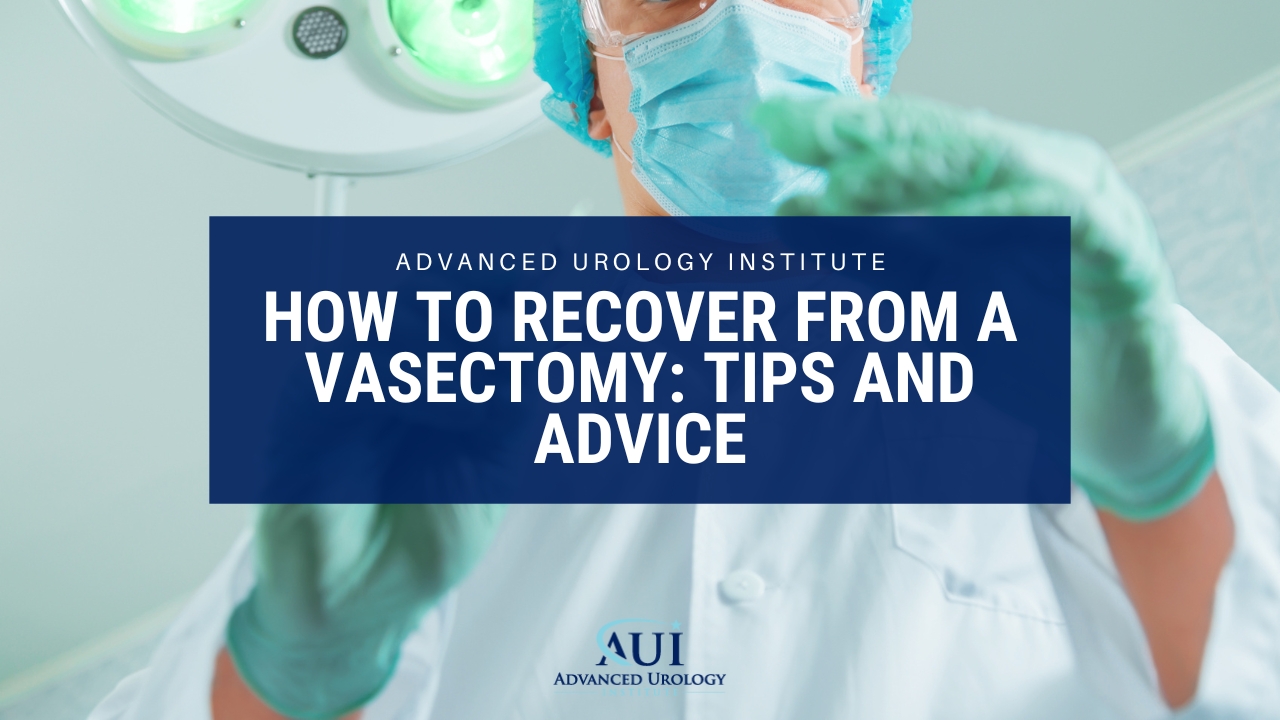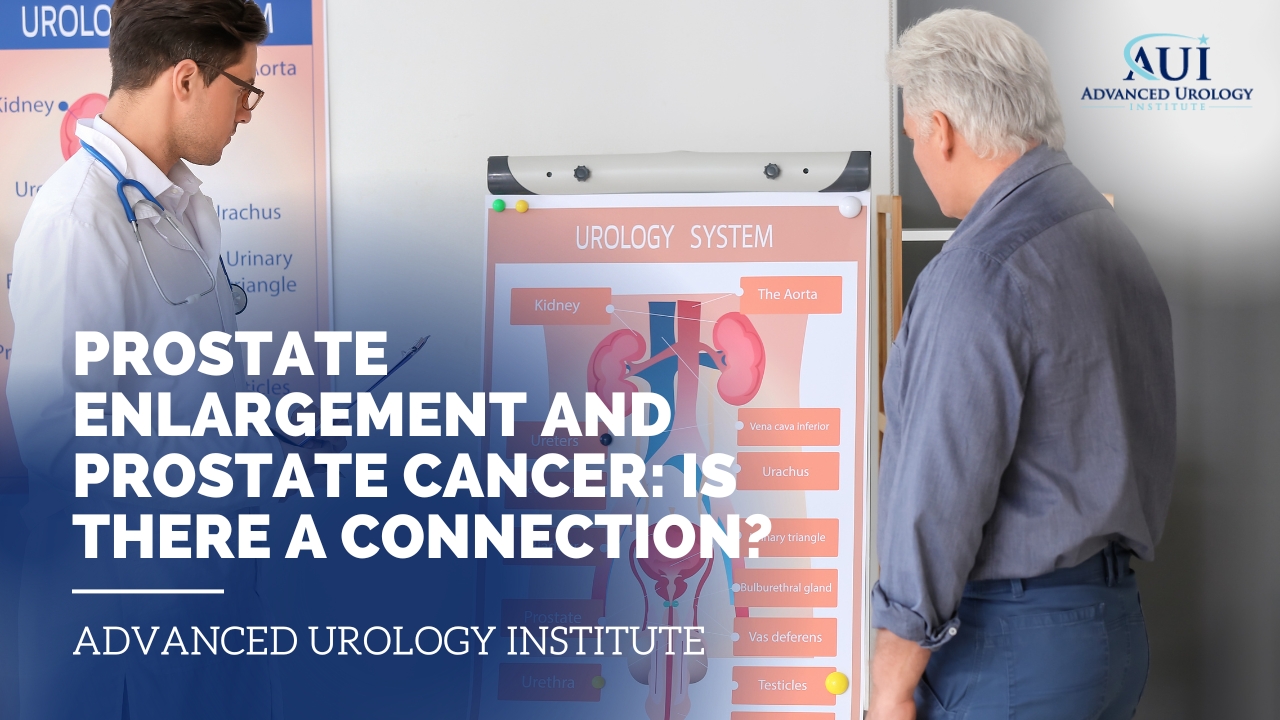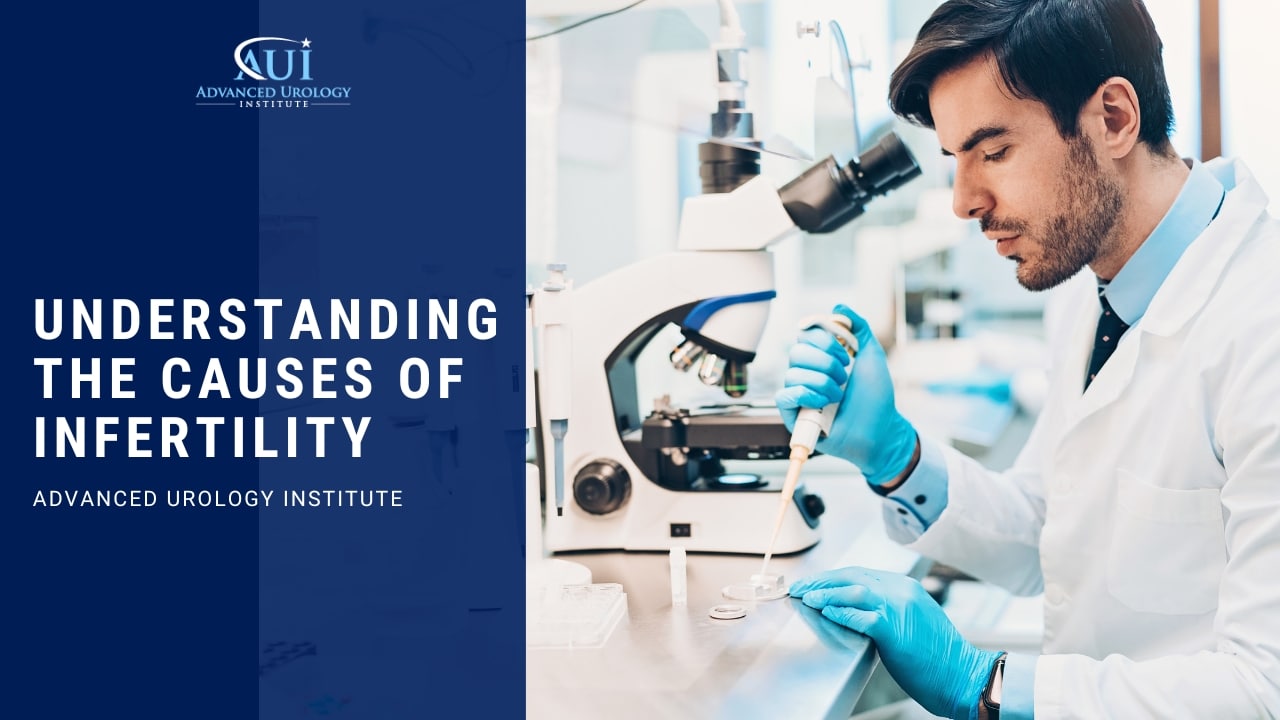It is very important for those who have had a vasectomy to do the necessary steps for recovery in order to avoid any further complications. This includes consulting with a medical professional before the procedure, having a clear understanding of the risks, and following the doctor’s instructions.
Continue readingTreatment Options That Are Available for Prostate Cancer – Dr. Amar Raval
In this video, Dr. Raval provides a clear and concise overview of the different treatment options for prostate cancer. It is important for patients to take an active role in their own care and work closely with their doctor to develop a treatment plan that is tailored to their individual needs and circumstances.
Continue readingDebunking the Top 5 Vasectomy Myths
It is no surprise then that so many questions and myths about vasectomies exist. This article debunks five of the most common vasectomy myths with evidence from clinical studies. With accurate information and knowledge that vasectomies are a safe, effective and long-term option, men can make an informed decision.
Continue readingProstate Enlargement and Prostate Cancer: Is there a Connection?
Prostate enlargement neither causes nor turns into prostate cancer, and is a completely separate condition. In fact, the risk of prostate cancer is lower in men with an enlarged prostate than in men without the condition. However, the two conditions are linked in various ways. Here are four ways in which BPH and prostate cancer are connected
Continue readingOvercoming UTI Recurrence: Tips for Prevention
Recurrent urinary tract infections (RUTIs) are due to persistent re-infection of any part of the urinary tract by the same pathogen. The infections can be really frustrating as they keep coming back. When you have recurrent UTIs, you can use antibiotics to clear the infection within a few days. You can also use the following simple measures to prevent UTIs.
Continue readingVasectomy and Age: Is There Right Time To Get the Procedure?
 Vasectomy is a permanent form of birth control that prevents a man from fathering biological children. The question of when to undergo the procedure is a personal one and there is no right time or age. However, on average, men tend to get the procedure at 35 years or older. It is important to note that a vasectomy is not recommended for men under the age of 18, and in some states, men under the age of 21 are not eligible for the procedure through federally-funded medical facilities.
Vasectomy is a permanent form of birth control that prevents a man from fathering biological children. The question of when to undergo the procedure is a personal one and there is no right time or age. However, on average, men tend to get the procedure at 35 years or older. It is important to note that a vasectomy is not recommended for men under the age of 18, and in some states, men under the age of 21 are not eligible for the procedure through federally-funded medical facilities.
It is important to make sure that you have given serious thought and consulted with professionals before making the decision to undergo the procedure. It is also important to consider factors such as your partner’s age and fertility. If your partner is nearing menopause or has a condition that prevents her from conceiving, a vasectomy may not be necessary.
It is also important to be aware that a change of mind is possible at any age, and it is crucial to thoroughly consider the decision before proceeding. If at any age, you are confident that you do not want children and a healthcare provider refuses to perform the procedure, it is recommended to seek a second opinion.
In terms of age limitations, there is no upper limit for a vasectomy as long as overall health is good enough. However, it is important to take into account any potential health risks and to discuss the pros and cons of the procedure with a healthcare professional. Ultimately, the right time to undergo a vasectomy is when you have fully considered the decision and are confident in your choice to not have any more biological children.
At Advanced Urology Institute, we prioritize your health, safety, and peace of mind. So, we ensure that we have enough time with you during consultation to explore the pros and cons of a vasectomy and make sure it is the right procedure for you. Book your consultation with us now to have your questions answered and to prepare yourself adequately for the procedure.
For more information on a vasectomy, vasectomy reversal, and other urological and male reproductive health services, visit the site “Advanced Urology Institute.”
Understanding The Causes of Infertility
Infertility can be a frustrating and emotionally challenging experience for couples trying to conceive. The causes of infertility can be attributed to health problems, environmental factors, or lifestyle choices.
Continue readingNatural remedies for an overactive bladder
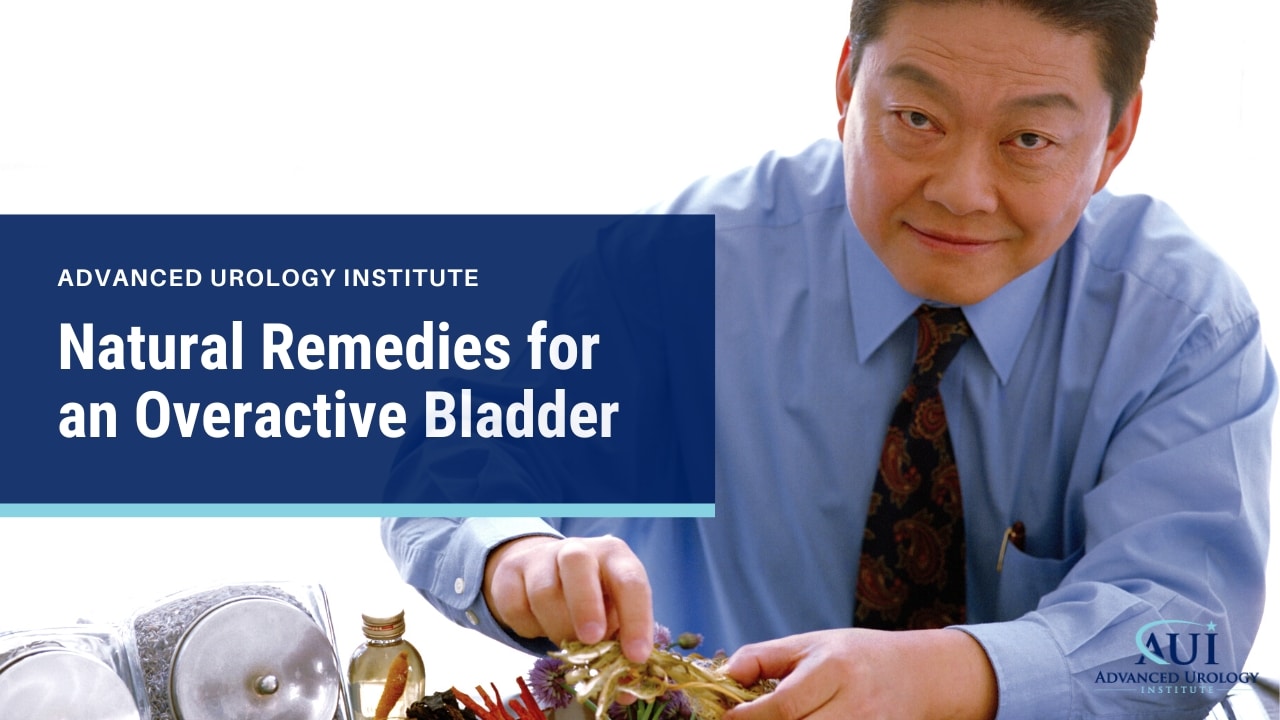 An overactive bladder (OAB) is a condition where you are not able to hold urine in your bladder due to involuntary bladder muscle contractions. It causes a frequent, sudden and difficult-to-control urge to pass urine, which may lead to unintentional loss of urine. You may also feel the urge to pass urine 8 or more times in 24 hours.
An overactive bladder (OAB) is a condition where you are not able to hold urine in your bladder due to involuntary bladder muscle contractions. It causes a frequent, sudden and difficult-to-control urge to pass urine, which may lead to unintentional loss of urine. You may also feel the urge to pass urine 8 or more times in 24 hours.
With an overactive bladder, the first-line treatment is usually behavioral and lifestyle changes. But if the condition remains troublesome even with the changes, further treatment may include medications, bladder injections, nerve stimulation, percutaneous tibial nerve stimulation (PTNS), or surgery.
So what are the natural remedies for an overactive bladder?
- Eliminating bladder irritants
Symptoms of an overactive bladder can be relieved by avoiding foods and drinks known to irritate the bladder.
Common culprits include alcohol, caffeine, artificial sweeteners, citrus fruits and juices, and chocolate. Other foods and drinks to avoid or reduce are sodas and fizzy drinks, cranberry juice, corn syrup, tomatoes, sugar, honey, vinegar, dairy, and spicy foods.
Since irritation from foods and drinks vary from person to person, you can benefit by keeping a diary of what you take and the associated bladder symptoms. A diary can help you work out which foods are causing you problems.
- Making lifestyle changes
Quitting smoking can remedy an overactive bladder. That’s because smoking tends to make the symptoms of the condition worse, while the coughing fits associated with smoking tend to increase OAB-associated leakage of urine.
Another change that can improve an overactive bladder is withdrawal of medications contributing to the problem. For instance, diuretics, antihistamines, muscle relaxants, sedatives, narcotics, and alpha-adrenergic antagonists worsen OAB symptoms. So if you’re taking any medications you suspect to be behind the problem, speak with your doctor about alternatives.
Also, losing weight can reduce the pressure on your bladder and pelvic floor muscles, and improve your bladder control.
- Using bladder control techniques
There are a number of bladder control techniques you can apply, including scheduled urination, delayed urination, and double-void technique.
- Scheduled urination
By scheduled urination, you keep a diary of your urinary habits, such as bathroom visits, any leakages, and urgency symptoms. Based on the patterns in your diary, you start scheduled bathroom trips aimed at adding at least 15 minutes to your normal urination times.
For example, if you pass urine every 60 minutes, you change this and schedule your bathroom breaks for every 75 minutes. Then you stick to these scheduled visits regardless of whether you feel the urge to pass urine or not. After that, you gradually increase the time interval between your bathroom visits
- Delayed urination
Delayed urination means every time you feel the urge to go, you try to delay by some minutes, if possible, usually by at least 5 minutes. You can use relaxation techniques, such as deep breathing to help delay. The aim is to gradually increase the delay time until you have achieved a 3-4 hour gap between your bathroom visits.
- Double voiding
Double voiding technique is useful if you feel your bladder does not empty fully. It is also worthwhile to double void before bedtime.
To do so, you sit in the toilet, lean slightly forward, rest your hands on your knees or thighs, and urinate as normal. Then you remain in the toilet and wait for another 30 seconds, leaning slightly further forward to urinate once more.
- Doing kegel exercises
Kegels involve strengthening exercises on the pelvic floor muscles, which are the muscles that help to control urine flow. To locate your pelvic floor muscles, try to stop urine flow midstream. If you succeed, it means you have located the muscles.
Now, practice squeezing these muscles for 10 seconds and relaxing for 3 seconds, repeating the pattern 10 times. Then try to do 3 sets of 10 repetitions daily. Deep breathe to make the process easier.
- Managing your fluid intake
Drinking plenty of water is essential for your health, and you shouldn’t stop because of an overactive bladder.
That’s because taking too little water allows your urine to be more concentrated, which may irritate your bladder lining and increase urgency. But excess fluid intake may also make frequency symptoms worse, such as fluid intake before bed contributing to urinating during the night.
Make sure to drink 6-8 glasses of water daily, but to avoid liquid intake 2-3 hours before going to bed.
- Using herbs and supplements
There are a number of herbs and supplements that are effective in treating an overactive bladder. Speak with your urologist about these options for recommendations, but don’t use them without your doctor’s advice.
Effective herbs and supplements include:
This is a blend of 10 traditional herbs that help with overactive bladder by increasing the bladder’s capacity and lowering bladder contractions. It reduces frequency, urgency, and nighttime urination in people with the condition.
- Capsaicin
Capsaicin is an extract from chili peppers. It works by blocking signals from the nerves in the bladder and ensures the bladder holds urine longer. Plus, it helps to manage pelvic pain syndrome, of which overactive bladder is usually a symptom.
- Pumpkin seed extract
The extract is effective in improving pelvic floor health. It helps to strengthen pelvic floor muscles and enhances control of muscles involved in passing urine.
- Magnesium hydroxide
Magnesium helps maintain normal blood pressure, reduces muscles spasms, and allows the bladder to empty fully. As an alternative to magnesium hydroxide, you can add magnesium rich foods, like bananas, kale, pumpkin seeds, and cashews to your diet if your doctor deems it safe.
- Saw palmetto
Saw palmetto has been tested in men with an enlarged prostate, where it has demonstrated efficacy in treating the condition as well as relieving bladder control symptoms. Hence, using it helps improve bladder issues associated with OAB.
- Resiniferatoxin
This is a chemical derived from a cactus-like plant. It is effective in blocking signals from the bladder nerves to the brain; hence, reducing the strength of the urge to pass urine, allows the bladder to hold urine longer, and relieves symptoms of an overactive bladder.
- Vitamin D
Increased intake of vitamin D lowers the risk of pelvic floor disorders, such as bladder leakage, especially in women. For older adults, more vitamin D in the diet or as a supplement effectively prevents bladder leakage.
This is an enzyme found in pineapple plant. It has powerful anti-inflammatory abilities and prevents bladder irritation. Therefore, it has a positive effect on those with an overactive bladder.
- Cornsilk
Cornsilk refers to the hair-like threads found on top of the ears of corn and beneath cornhusks. It is rich in flavonoids and is helpful in relieving bladder control symptoms by reducing inflammation and protecting the bladder wall against irritation.
- Cleavers
This is a wild flower with tiny hooks on its stems, seeds, and leaves. It reduces bladder inflammation and protects the bladder wall from irritation.
At Advanced Urology Institute, we are known for our comprehensive, accurate diagnosis and tailored approach to treating urological disorders. With an overactive bladder, we make sure to establish the underlying cause, whether weak or stretched pelvic floor muscles, an enlarged prostate, chronic UTI, obesity, diabetes, or a nerve problem.
Then, as first-line treatment, we often recommend natural remedies such as behavioral, lifestyle and dietary changes. For a more bothersome and persistent overactive bladder, we offer a variety of surgical and non-surgical interventions.
For more information on an overactive bladder and other urological disorders, visit the site “Advanced Urology Institute.”
Can kidney stones go away on their own?
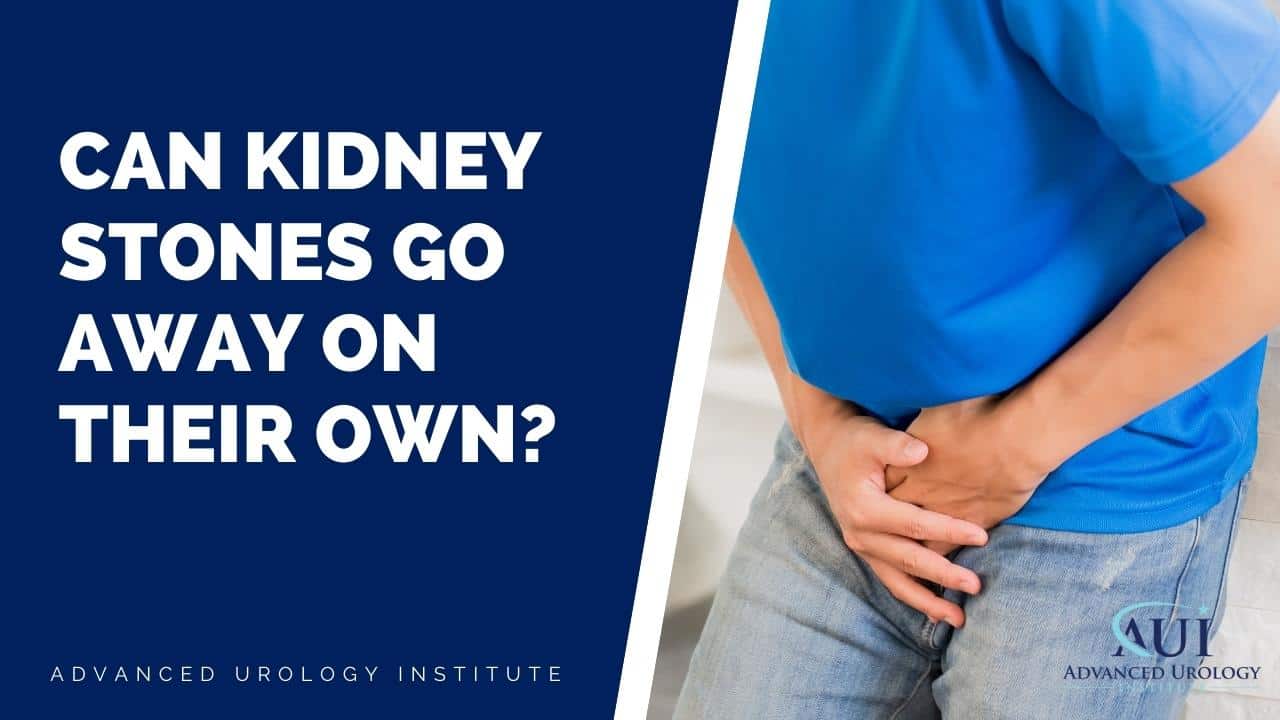 Kidney stones that range from 0.5 to 4.0 millimeters in diameter can and often do go away on their own. Such stones pass easily in urine without causing pain as long as there is adequate water intake to increase urine flow and aid their passage. These stones pass on their own within a few days, though most will do so within 2-3 weeks.
Kidney stones that range from 0.5 to 4.0 millimeters in diameter can and often do go away on their own. Such stones pass easily in urine without causing pain as long as there is adequate water intake to increase urine flow and aid their passage. These stones pass on their own within a few days, though most will do so within 2-3 weeks.
Problematic kidney stones
On the other hand, kidney stones that are 5 millimeters or bigger in diameter don’t go away easily on their own. As they move down the urinary tract, they may get stuck and cause severe pain that may require narcotics for initial pain relief.
Then as the stone continues to move down the urinary tract, NSAIDs (non-steroidal anti-inflammatory medication) can be used to manage the pain. Drinking a lot of water may help to pass such stones.
With guidance and supervision of your urologist, you can stay at home and wait for kidney stones to pass on their own. But when in too much pain, you may need hospitalization for pain control and intravenous (IV) fluids to boost hydration and further help the stones to pass.
Medication to help bothersome stones pass
Kidney stones that are 5-10 millimeters in diameter may be problematic, but they still have a reasonable chance of going away on their own. To aid their passage, your urologist may prescribe the drug tamsulosin (Flomax), an alpha-blocker medication that relaxes the muscles of the distal ureter—the portion of the ureter right above your bladder.
Relaxing the ureter helps kidney stones to pass on their own in urine over a period of 2-4 weeks. It also relieves discomfort associated with the stones. But tamsulosin is equally a well tolerated drug that increases the probability of passing a stone from home and without further medical intervention.
Of course, giving the drug does not guarantee that the stone will pass in urine. However, as long as there is no severe pain that needs hospital admission for a surgical procedure, the drug is great option for passing kidney stones from home.
When is surgery the best option?
If kidney stones fail to go away on their own for up to 6 weeks, surgery is the best option. In fact, a timely surgical removal of the stones helps to avoid possible blockage of the ureter.
Ureter blockage can cause pain, problems with urination, blood in urine, and changes in the amount of urine produced. Also, if left untreated, a stone that is blocking urine flow can cause complications, such as recurrent urinary tract infections (UTI), hydronephrosis, and permanent kidney damage.
Equally, when kidney stones occur alongside a urinary tract infection, sepsis may develop. Since sepsis is a life-threatening condition, it may be necessary to have a tube (catheter) placed in the ureter or kidney to drain the infected urine.
Surgical interventions include:
- Shock wave lithotripsy
It is the least invasive outpatient procedure for removing kidney stones that fail to pass on their own. A urologist uses a machine to generate waves that are then targeted at the kidney stone with the help of imaging guidance. No incisions are made.
A stone is hit several times with the waves in a procedure that takes roughly 2 hours and with the patient under general anesthesia. In the process, the stone breaks into smaller pieces, which go away on their own in urine without much discomfort.
Shock wave lithotripsy is advisable for smaller kidney stones, 2 centimeters or less in diameter, but that are located high up in the kidney.
- Ureteroscopy
For kidney stones 1.0 to 1.5 centimeters in diameter, ureteroscopy is an effective option. The minimally invasive outpatient procedure involves placing a small, lighted tube with a camera at its tip—ureteroscope—into the urethra, then into the bladder, and further up the ureter.
A smaller laser device is then passed through the scope to help break down the stone. The resulting stone fragments are removed via a basket, a stent, or rubber tube passed through the scope.
- Percutaneous nephrolithotomy and nephrolithotripsy
When kidney stones are bigger than 2 centimeters in diameter, percutaneous nephrolithotomy or nephrolithotripsy is the preferred surgical intervention. In both procedures, the urologist makes an incision in the back to create a pathway to the kidney.
A nephroscope—a tube with surgical tools and a camera on its tip—is inserted through the incision. If the surgical tools are used to remove the stone, the procedure is called nephrolithotomy. But when the tools are only used to break up the stone, the procedure is called nephrolithotripsy.
Through the nephroscope, the doctor administers a laser or ultrasonic device that vibrates at high frequency to fragment the stone. Then suction is passed via the tube to remove the fragments. The doctor may also insert a stent in the ureter to help with swelling and enable the patient to urinate.
- Robotic assisted laparoscopic nephrolithotomy
For patients with bigger, more problematic stones, robotic assisted surgery is a great option. During the procedure, the surgeon makes small incisions in the abdomen through which a laparoscope (a lighted tube with tiny surgical tools and a camera at its tip) is inserted.
Using the surgical tools controlled by a computer console in the operating room, the doctor accesses and opens up the kidney to remove the stone.
Are you suspecting that you have kidney stones? At Advanced Urology Institute, we offer a range of surgical and non-surgical interventions to deal with kidney stones.
For more information on prevention and treatment of kidney stones and other urological problems, visit the site “Advanced Urology Institute.”
What happens to sperm after a vasectomy?
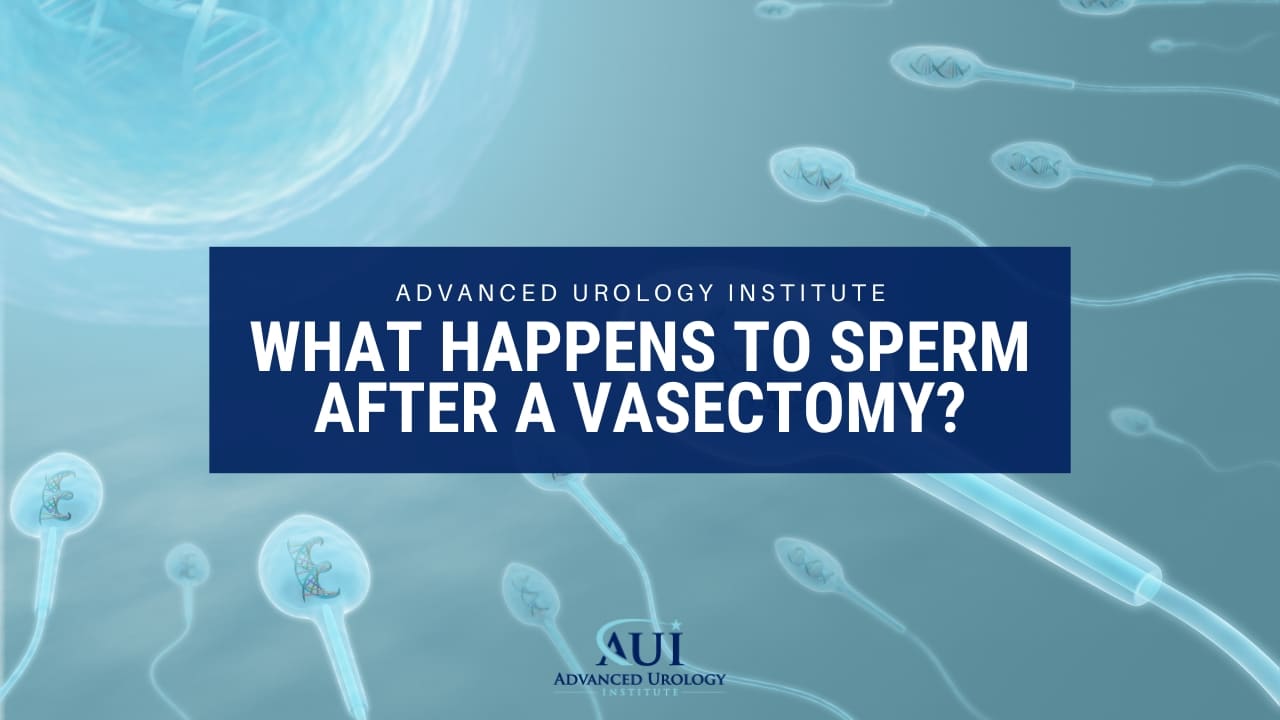 Are you a man intending to undergo a vasectomy but aren’t sure about its efficacy?
Are you a man intending to undergo a vasectomy but aren’t sure about its efficacy?
Are you worried that the procedure will affect your sexual desire, performance or pleasure?
Or are you anxious that the sperm prevented from reaching your ejaculate may cause adverse effects in your body?
If so, here is what you should know about the fate of your sperm after a vasectomy.
- Your body continues to produce sperm after a vasectomy
A vasectomy doesn’t stop your body from producing sperm. It only stops the sperm produced from being part of the fluid you ejaculate. The procedure does not in any way interfere with your testicles, which is your body’s sperm factory.
Inside the testicles are tiny, coiled tubes known as the seminiferous tubules. The tubules produce sperm throughout your lifetime. They contain cells called sperm nurse cells that control the sperm stem cells from where new sperm cells emerge. The sperm nurse cells are surrounded and stimulated by testosterone-producing cells.
Vasectomy does not affect any of these cells found in the seminiferous tubules. So it does not hamper or limit sperm production. And your body continues to produce sperm just as it did before the procedure.
- Your body naturally dissolves and reabsorbs sperm after a vasectomy
Before a vasectomy, the sperm produced in your testicles are moved and stored in the tightly coiled tube, called the epididymis. The sperm cells stored in the epididymis are then transferred to the vas deferens and out of the body via the urethra during ejaculation.
During a vasectomy, the vas deferens is cut and blocked, closing the pathway along which sperm move out of the body. So the sperm produced in the testicles and stored in the epididymis can no longer move out of the epididymis through the vas deferens to be part of the semen you ejaculate.
The sperm remains stored and unused in the epididymis for a period of time. After that, the body’s natural destruction process occurs, where the sperm is dissolved and reabsorbed into the body through the membrane lining the epididymis.
- Your body’s re-absorption of unused sperm is harmless
The process of re-absorbing sperm in your body after a vasectomy is similar to what happens to the sperm the body produces during periods when you are sexually inactive. Of course, when you’re sexually active, you ejaculate regularly, use most of the sperm produced, and compel the body to make more sperm.
But when you are sexually inactive for an extended period of time, your body produces less sperm and stores and reabsorbs unused sperm. It is this same process of naturally re-absorbing unused sperm that occurs after a vasectomy. The natural, harmless process swings into action to prevent buildup of unused sperm if you don’t ejaculate for a long period.
The process occurs in two steps. First, the body uses special cleanup cells called macrophages to break down old or unused sperm by dissolving them. Secondly, the remnants of broken-down sperm cells are absorbed into the membrane lining the epididymis.
- Your sexual desire, function, and pleasure does not change after a vasectomy
Because the vasectomy procedure does not affect your testicles, it does not interfere with your testosterone levels. So your sexual desire is not affected.
Also, a vasectomy does not interfere with your ability to have and maintain an erection. So if you have no erectile dysfunction before the procedure, you’ll have normal erections and performance after it. In fact, your performance may be improved by the boost you get from not worrying about the risks of pregnancy.
Likewise, since the ejaculate is usually made up of 2-5 percent sperm, the volume of your ejaculate does not change after a vasectomy. You’ll be able to have sex, feel the same levels of pleasure, and ejaculate normally. The only difference will be the absence of sperm in the ejaculate.
- You need an alternative form of contraception until your semen is sperm-free
With a long-term success rate of 99-percent, a vasectomy is one of the best forms of birth control; only second to abstinence. But you’ll still need to be careful a few weeks after the procedure as you can still make your partner pregnant.
There will be some sperm in the upper portion of the vas deferens after a vasectomy. These sperm cells will find their way in semen and may cause a pregnancy if you have sex after the procedure. That is why you need to use an alternative form of birth control until the absence of sperm in your semen has been confirmed.
The sperm count in semen decreases gradually after a vasectomy. But it takes approximately 8 weeks or 20 ejaculations following a vasectomy for the semen to be sperm-free. Your doctor will recommend tests on your semen during this period to check for the presence of sperm.
Safe, effective vasectomy
Vasectomy is a safe, effective, and permanent birth control method. It neither interferes with your sex life nor stops your body from producing sperm. It only stops sperm from being part of the ejaculate, but with not much difference in the color and quantity of semen you ejaculate.
At Advanced Urology Institute, we offer safe, effective vasectomy procedures. Before the procedure, we spend time discussing the procedure and its benefits and risks ensuring that our patients are ready for permanent birth control. We also offer vasectomy reversal for men who have undergone the procedure but for some reasons need to have children again.
For more information on vasectomy and vasectomy reversal, visit the site “Advanced Urology Institute.”
The Pros and Cons of Penile Enhancement
 Penis enhancement surgery is a procedure to correct structural and functional problems of the penis. It may be recommended after an injury, defect, or loss of function. But usually, it is a corrective measure for a micropenis or a buried penis, both of which cause functional issues with urinating, sexual intercourse or hygiene.
Penis enhancement surgery is a procedure to correct structural and functional problems of the penis. It may be recommended after an injury, defect, or loss of function. But usually, it is a corrective measure for a micropenis or a buried penis, both of which cause functional issues with urinating, sexual intercourse or hygiene.
In rare cases, the procedure may be considered for making the penis longer or larger. It may also be used to make the stomach smaller in order to allow the penis to appear longer and wider. But surgery to increase size or width of the penis is medically discouraged and is a deeply personal decision that requires careful consideration.
That’s because most men who usually think they have a small penis tend to actually have a normal-sized penis. Also, most of the penis enhancement claims are false and tend to involve techniques and products that may be harmful to the penis.
Alternatives to surgery
- Jelqing exercises
Jelqing is a natural penis enlargement exercise involving a hand-over-hand rolling motion to increase blood flow to the head of the penis and stretch the organ. Though a fairly safe practice that can enhance the penis, it is not backed by enough medical studies and may lead to pain, irritation, or scar tissue formation if done too often or aggressively.
- Pills, potions, and lotions
While there are numerous penile enlargement vitamins, pills, herbal preparations, hormones, and lotions, most of the claims about them aren’t supported by evidence. Some may even interfere or interact with other medications or be harmful to users.
- Penile extenders
Penile extenders are non-invasive devices that use traction to stretch the penis. Studies have reported that extenders help to increase the length of a flaccid penis by more than 1.5 centimeters after 3 months of use.
But more research is necessary to assess their safety and effectiveness. Plus, they are uncomfortable and cumbersome to use, and can overstretch the penis causing nerve damage, bruising, or blood clots.
- Vacuum pump
Though they are designed to treat erectile dysfunction, some people use them to occasionally “exercise” and stretch their penis. In the process, they can trigger tissue damage and cause erectile problems.
- Clamps and rings
Clamps and rings are used by some people to stretch and elongate their penis. The devices are placed around the base of an erect penis to reduce blood flow out of the penis. While wearing one of these devices may temporarily enlarge the penis, having it on for more than 30 minutes may cut off blood flow and damage penile tissues.
What are the pros and cons of penile enhancement surgery?
Typically, a urologist recommends penile enhancement surgery to correct an injury, treat a defect, or improve function of the organ. Only in very rare cases can the doctor recommend surgery to increase the length or width of the penis.
That’s because penis enhancement surgery comes with the risk of serious complications such as scarring, pain, infection, loss of penile sensation, and erectile dysfunction.
Pros of penis enhancement surgery
- Helps to correct a micropenis—defined as a very small penis. A micropenis is a condition you’re born with, but which needs correction because it causes functional problems.
- Helps to correct a buried penis—defined as a penis buried under the skin from your stomach, thighs or scrotum. A buried penis can be a congenital condition or a result of aging.
- Helps to restore a functional penis by correction of penile abnormalities caused by injuries or disease. Penile abnormalities may make it difficult to urinate while standing up or hinder penetrative sexual intercourse.
- Helps to achieve a satisfactory appearance of the penis, particularly in those with persistent, bothersome, and embarrassing concerns about their penis size or width.
- Helps to create a new sense of masculinity and sexual potency, which in turn improves personal relationships, overall mood, and productivity in daily work.
- Helps to increase confidence and self-esteem by achieving a penis length and girth that meets personal goals and expectations.
Cons of penis enhancement
- Is associated with surgery risks such possible infection, bleeding, or damage to nerve endings.
- There may be adverse reactions to anesthesia.
- It may produce a lop-sided penis appearance, where the penis seems to hang from the scrotum instead of from the abdomen.
- Fat used to widen or enlarge the penis can be reabsorbed, which eventually reduces the width of the enhanced penis.
Safe, effective penis enhancement
At Advanced Urology Institute, we perform penis enhancement surgery on a regular basis to correct congenital and acquired micropenis. The goal of the surgery is usually to restore a functional penis size in order to achieve normal standing urination, satisfying sexual intercourse, and enhanced quality of life.
Occasionally, we perform penis enhancement procedure on men with normal length penises, but who perceive themselves to have small ones—something that is usually a psychological condition. But for such a procedure, a lot more consultations and a multidisciplinary approach are usually necessary to come up with a highly individualized surgery that meets patient goals and expectations.
For more information on penis enhancement and other procedures for treating urologic disorders, visit the site “Advanced Urology Institute.”
Early detection of prostate problems
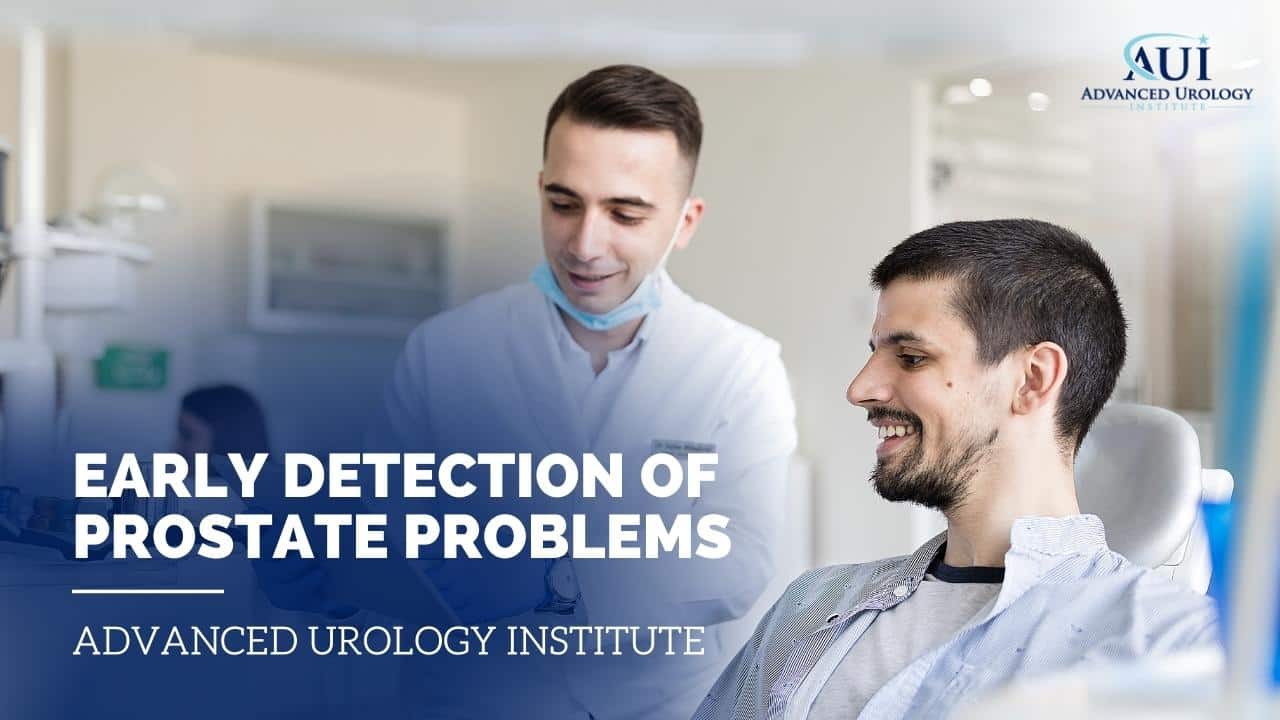 The prostate is a tiny gland located just beneath the bladder and in front of the rectum. It surrounds the urethra and produces fluid that forms part of the semen.
The prostate is a tiny gland located just beneath the bladder and in front of the rectum. It surrounds the urethra and produces fluid that forms part of the semen.
Though small in size, the prostate is one of the most talked-about glands in men and which causes a lot of concerns. In fact, all men are at risk of developing prostate problems.
The prostate problems include:
- Prostatitis
This is an issue frequently associated with young and middle-aged men. Prostatitis refers to inflammation of the prostate due to a bacterial infection or other cause. Only 5-10 percent of men develop prostatitis in their lifetime.
- Benign prostatic hyperplasia (BPH)
Also called an enlarged prostate, BPH is the growth of the prostate gland to a large, unhealthy size. The risk of having the problem increases with age.
While just 8-percent of men in the ages 31-40 may develop the condition, up to 50-percent of men aged 51-60 years and more than 80-percent of men aged over 80 years have BPH.
An enlarged prostate is neither prostate cancer nor a cause of the cancer. Also, only 50-percent of men with BPH develop symptoms that are severe enough to warrant treatment.
- Prostate cancer
Prostate cancer is one of the most common cancers in men with more than 16 percent of men diagnosed with the cancer in their lifetime. Nevertheless, it is a slow-growing cancer and only about 2-percent of men end up dying of the cancer.
Just like BPH, the risk of having prostate cancer increases with age. In fact, 75-percent of men with the cancer are usually aged 65 years and older.
The exact cause of prostate cancer is unknown, but risk factors include family history and race. For instance, if you have a brother or father with prostate cancer your risk of the disease increases by more than double. Also, African-American men are at a greater risk of the cancer than Caucasians.
That is why African-American men and those with family history of the disease are advised to begin screening at an earlier age than the rest of men.
Symptoms of prostate problems
Because the prostate is located just beneath the bladder and surrounds the urethra, problems with the gland usually result in urinary symptoms.
For instance, while prostatitis rarely shows symptoms, it may cause:
- Pain when urinating or ejaculating
- Turbid or cloudy urine
- An urge to urinate more often
- Pelvic pain
- Chills and fever
Like prostatitis, an enlarged prostate may not cause symptoms until it compresses the urethra and makes urination difficult. When it shows symptoms, BPH produces:
- Frequent urination, particularly at night
- Inability to delay urination
- Difficulty starting or stopping urination
- Feeling as if you can’t get all urine out
- Weak urine stream or interrupted stream
- Dribbling at the end of urination
- Accidental loss of urine
- Pain during urination or after ejaculation
- Urine of unusual smell or color
Early-stage prostate cancer does not usually show symptoms and is often only discovered after screening with the prostate-specific antigen (PSA) test or the digital rectal exam (DRE). But advanced prostate cancer shows symptoms such as:
- Trouble urinating
- Blood in urine or semen
- Reduced force in urine stream
- Inability to urinate
- Pain or burning sensation during urination
- Blood in urine or ejaculate
- Bone pain
- Back pain
- Erectile dysfunction
- Loss of weight without trying
Early detection of prostate problems
- Prostatitis
With prostatitis, the infection is detected early through symptoms. For example, acute bacterial prostatitis tends to begin suddenly, producing chills, fever, or pain in addition to urinary symptoms. Visiting the doctor right away helps to diagnose and treat the infection.
Chronic bacterial prostatitis is a prostate infection that recurs. It is detected via reappearance of similar symptoms that trigger visits to the doctor. When diagnosed, it is managed with antibiotics, though it is quite hard to treat.
Equally, chronic prostatitis, also called chronic pelvic pain syndrome, can be detected early through symptoms such as persistent pain in the lower back, groin or tip of the penis. It is treated with a combination of medicines, surgery and lifestyle changes.
- An Enlarged Prostate
Like prostatitis, an enlarged prostate can be detected early through symptoms—though such symptoms do not usually match the severity of the condition. That is why men who start to experience urinary symptoms should consult a urologist as soon as possible.
An early visit to a urologist when you have symptoms helps to:
- Catch BPH in early stages when less invasive procedures are most effective.
- Bring the symptoms under control and improve quality of life.
- Rule out other potential causes of urinary symptoms, such as prostate cancer.
- Prostate Cancer
Since prostate cancer tends to show no early warning signs and only produces symptoms when at an advanced stage, early detection is not achieved through symptoms. Instead, the cancer is detected early by screening tests, usually prostate-specific antigen (PSA) test and digital rectal exam (DRE).
Screening means testing to find prostate cancer in a man without symptoms. The tests used do not provide a diagnosis, but offer valuable information to help find the disease early. Plus, the tests are quick and safe.
Should you undergo screening for prostate cancer?
Screening for prostate cancer is controversial—while some doctors and organizations recommend regular screenings other organizations don’t.
According to the American Cancer Society, you should speak with your doctor about the benefits, risks, and limitations of screening before you make the decision to get tested. The organization asserts that you should not undergo PSA blood testing before this discussion. And that the discussion should begin at age 45 if you’re a man at higher risk and at age 50 if you have average risk of the cancer.
Another organization, the American Urological Association, recommends speaking with your doctor about the risks and benefits of prostate cancer screening when you’re aged 55 to 69 years. But that you should only proceed with testing based on your preferences and personal values.
American Urological Association:
- Does not recommend PSA screening if you are below 40 years.
- Does not recommend routine PSA screening if you are between the ages 40-54 and at an average risk of the cancer.
- Does not recommend PSA screening in men aged over 70 years and those with a life-expectancy of less than 10 years.
- Does not recommend annual screening, but instead routine screening at intervals of 2 years or more, which must be preceded by a discussion with your doctor.
The United States Preventive Services Task Force does not recommend routine PSA screening for men in the general population, regardless of age. According to the organization, routine cancer screening can detect slow-growing cancers, which are then managed using therapeutic techniques with serious adverse effects but with no much benefit to the patient.
Prompt effective diagnosis of prostate problems
At Advanced Urology Institute, we are committed to early detection of prostate problems. We believe that it is important for patients to participate in screening programs for patients with the chance to speak with experienced physicians and the opportunity for informed decision-making and timely follow-up care.
We provide our patients with open, compassionate consultations that allow for informed decision-making and proper follow-up care, resulting in access to high-quality, objective diagnosis and treatment decisions. Plus, we guard against screening related problems, such as over-diagnosis and treatment of clinically insignificant conditions.
For more information on prostate cancer and other urological disorders, visit the site “Advanced Urology Institute.”
Are You at Risk for Bladder Cancer?
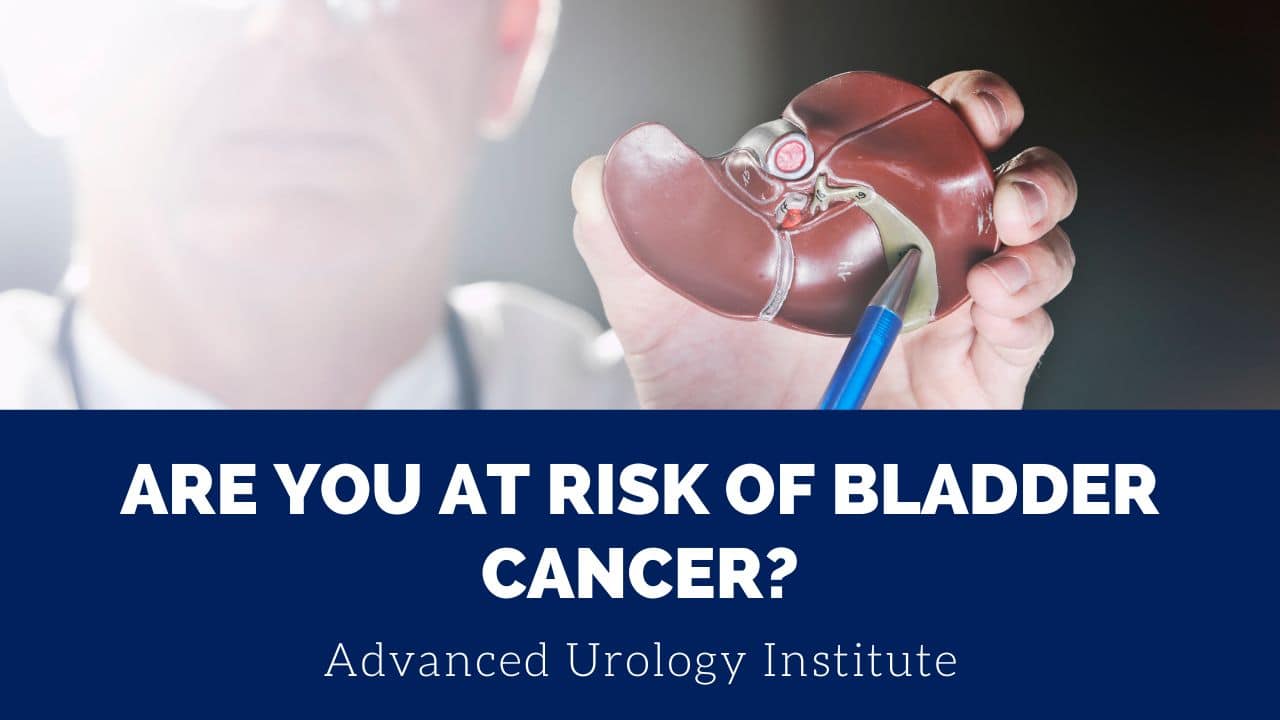 Bladder cancer is a common type of urological cancer that begins in cells of the bladder. The bladder is a hollow muscular organ in the lower abdomen where urine is stored.
Bladder cancer is a common type of urological cancer that begins in cells of the bladder. The bladder is a hollow muscular organ in the lower abdomen where urine is stored.
The cancer starts when cells of the bladder undergo changes, called mutations, in their DNA. Due to the changes, the cells multiply rapidly and uncontrollably. And they are also able to survive when normal and healthy cells die.
As a mass of abnormal cells builds forming a tumor, the resulting tumor invades and destroys normal bladder tissues and may even break away and spread through the body.
What are the different types of bladder cancer?
- Urothelial carcinoma (transitional cell carcinoma)
This is the most common type of bladder cancer. It occurs in the cells of the inner lining of the bladder, called urothelial cells. After cancer begins in these cells it often spreads to adjacent tissues and can even invade distant organs.
- Squamous cell carcinoma
This is a rare type of bladder cancer that tends to occur after an infection or long-term use of a urinary catheter. It is associated with chronic irritation of the bladder and can be caused by certain parasitic infections, such as schistosomiasis.
- Adenocarcinoma
This is also a less common type of bladder cancer. Adenocarcinoma occurs in the cells that form mucus-secreting glands in the bladder before invading adjacent tissues.
Who is at risk of bladder cancer?
- A smoker
Smoking of cigarettes is the most common association and causes of bladder cancer. In fact, smoking generally including cigars and pipes can also increase the risk of cancer. Cigarette and tobacco smoke contains harmful chemicals that reach the bloodstream and are excreted in urine.
When the chemicals linger in the bladder, they damage or cause changes in cells. This increases the risk of cancer. In fact, cigarette smokers have three times more risk of bladder cancer than non-smokers.
- A person over the age of 55 years
While bladder cancer can occur at any age, it is more often diagnosed in people above the age of 55 years. And with up to 90-percent of those with the cancer being aged 55 years or older, aging is a major risk factor for bladder cancer.
- Being male
Being male predisposes you to a higher risk of bladder cancer than being female. In fact, men are four times more likely to develop cancer than women. However, women have a higher likelihood of late diagnosis of the cancer, which makes them more likely to die of the disease than men.
- Being white
Race is a factor in bladder cancer. Generally, white people are twice as likely to be diagnosed with bladder cancer than black people. Nevertheless, black people are twice as likely to die from the disease as white people.
- Being frequently exposed to certain harmful chemicals
Frequent exposure to certain chemicals increases the risk of bladder cancer. For example, in places where arsenic is found in drinking water, there is a higher incidence of cancer.
Also, people repeatedly exposed to aromatic amines, such as benzidine and beta-naphthylamine, often used in the dye industry, have a higher risk of cancer. Likewise, chemicals used to manufacture dyes, rubber, leather, paint, and textile products increase the risk of bladder cancer.
That is why painters, printers, machinists, hairdressers (due to heavy exposure to hair dyes), truck drivers (exposure to diesel fumes), and industrial workers in rubber, leather, textile, and paint factories have greater risk of bladder cancer.
The chemicals reach the bloodstream and get filtered by the kidneys, allowing them to be present in urine. Once in urine, they may cause mutation of bladder cells, which eventually triggers cancer.
- A person with chronic bladder inflammation
Repeated bladder inflammation causes changes in bladder cells and may result in cancer. Hence, conditions such as kidney and bladder stones, recurrent urinary tract infections, chronic inflammation (cystitis), and long-term use of a urinary catheter increase the risk of bladder cancer.
- A person with personal or family history of bladder cancer
If you have had previous bladder cancer, you’re more likely to get it again. Also, if you have blood relatives—a sibling, parent or child—who has had the cancer, you have a greater risk of the cancer, though it is rare for the disease to run in families.
- A person who has previously been treated for cancer
When you have been treated with the anti-cancer drug cyclo-phosphamide, you have a higher risk of bladder cancer. Similarly, if you have received radiation treatment aimed at your pelvis for a previous cancer, then you have a greater risk of developing bladder cancer.
How can you prevent bladder cancer?
While there is no guaranteed way of preventing bladder cancer, taking certain steps can reduce your risk of the disease. Useful preventative steps include:
- Avoiding smoking
If you’re not a smoker, just don’t start. And if you smoke, speak with your doctor about a tailored plan to help you stop. Medications, support groups, and other methods may help.
- Taking precautions when around certain chemicals
When working with various chemicals, follow the necessary safety precautions to avoid exposure.
- Eating a diet rich in fruits and vegetables
A diet rich in vegetables and fruits will provide antioxidants that help reduce the risk of bladder cancer.
- Drinking enough fluid
When you drink a lot of fluid, particularly water, you lower your risk of bladder cancer. More fluid intake helps you to empty your bladder more frequently and ensures harmful chemicals do not linger in your bladder long enough to cause damage.
Compassionate, patient-centered cancer care
If you see blood in your urine, you could have bladder cancer and should be seen by a board certified urologist.
Would you like to undergo timely and accurate screening and diagnostic tests for bladder cancer?
Through our compassionate, patient-centered approach, Advanced Urology Institute ensures that all patients get quality time with urology oncologists, have their concerns addressed and undergo comprehensive screening and diagnostic testing.
For more information on bladder cancer and other urological disorders, visit the site “Advanced Urology Institute.”
7 Signs You Might Have Kidney Stones
 An elevated amount of salts and minerals in urine can cause kidney stones. Also called renal calculi, kidney stones are hard deposits made of crystal-forming substances such as calcium, uric acid and oxalate, found in urine. The stones vary in size, with some being too small, some a few inches across, and others large enough to take up an entire kidney.
An elevated amount of salts and minerals in urine can cause kidney stones. Also called renal calculi, kidney stones are hard deposits made of crystal-forming substances such as calcium, uric acid and oxalate, found in urine. The stones vary in size, with some being too small, some a few inches across, and others large enough to take up an entire kidney.
For smaller renal stones, there are usually no associated signs. The stones can travel from the kidneys through ureters, bladder and urethra without causing any problems. And drinking plenty of water really helps in passing these stones.
But for larger kidney stones, signs appear as the stones move from one part of the urinary tract to another. An example is when a moderate or large stone moves from the kidney to the ureter. It immediately causes obstruction and produces agonizing pain. Such stones require a procedure, such as shock wave lithotripsy, to break up and remove them.
So what are the signs that you might have kidney stones?
- Pain in your lower back, side, or belly
Kidney stones produce one of the most severe types of pain—comparable only to getting stabbed by a knife or pain during childbirth. The pain tends to begin when the stone moves into the ureter, causing a blockage and pressure buildup in the kidney. This pressure activates nerve fibers to send pain signals to the brain.
The pain starts suddenly and changes location and intensity as the stone moves. It also comes and goes in waves, with each wave lasting a few minutes, disappearing, and then coming back. The pain usually occurs along the side and back, below the ribs, but can radiate to the belly and groin area as the stone moves down the urinary tract.
- Tossing and turning
The sudden episodes of kidney stone pain last 20-60 minutes. But they are so severe that they don’t allow you to sit still. So you’re forced to move around, toss and turn, in order to find a more comfortable position.
- Burning sensation during urination
When a kidney stone reaches the junction between the ureter and bladder, it causes sharp or burning pain during urination. It is quite easy to mistake the stone for a urinary tract infection (UTI). Of course, it is also common to have an infection alongside a kidney stone.
Apart from pain during urination, kidney stones can cause urinary frequency and urgency as they pass to the lower part of the urinary tract. That’s because a stone irritates the walls of the bladder and causes contraction, resulting in the urge to pass urine. You may find yourself running to the bathroom frequently or feeling the urge to go throughout the day and night.
- Nausea and vomiting
Kidney stones can cause obstruction of urine flow. This makes urine to back up, stretching or swelling the kidneys. Eventually, this may lead to nausea and vomiting.
Also, due to the excruciating pain associated with kidney stones, you may experience nausea and vomiting as one of the responses.
Equally, due to the sharing of nerve connections between the kidneys and the gastrointestinal tract, the presence of stones in the urinary tract disrupts nerves in the intestinal tract, resulting in stomach upset.
- Blood in urine
Kidney stones irritate the delicate tissues that line the urinary tract, including inside the ureter. As a result, there may be significant, microscopic, or moderate bleeding, which results in blood in urine (hematuria).
So as a sign of kidney stones, your urine may look grossly red, pink, or brown. You may also have blood in urine, but in quantities that are too small to notice with the naked eye. In that case, a urine test may be necessary to detect the urine.
- Fever and chills
Though fever is not a common sign of kidney stones, it may occur when the stones block urine flow or if the stones cause conditions that allow for an infection. Like fever, chills tend to occur due to an infection that arises as a complication of kidney stones.
When they occur, fever and chills are usually a medical emergency. And so, the obstruction should immediately be dealt with through a procedure such as shock wave lithotripsy to enable antibiotics to pass through the obstructed area.
- Smelly or cloudy urine
Urine that is healthy tends to be clear and without a strong odor, but turbid, smelly urine might indicate an infection. So, while foul-smelling or cloudy urine does not directly indicate kidney stones, it may point towards an infection that arises as a complication of renal stones.
Generally, more than 16-percent of people with acute kidney stones tend to have UTIs. And whether it occurs with or without fever, the combined presence of a UTI and kidney stones is a surgical emergency.
When should you see a doctor?
You should see your doctor when you have agonizing pain, nausea, vomiting, bloody, turbid or smelly urine, fever or chills. It is advisable to seek immediate medical attention when you have pain that is so severe that you can’t get comfortable. For more information on kidney stone treatment, visit the site “Advanced Urology Institute.”
Medtronic’s InterStim Therapy for Incontinence with Dr. Ali Syed
You have probably heard the term incontinence, but do you really know what it is? Incontinence is loss of control of a person’s bowels or bladder that results in accidental leakage of body fluids and waste. Therefore, it’s a physical problem but also one that can diminish quality of life. Someone dealing with incontinence may avoid sex, physical activities, social outings, and hobbies out of fear they may leak urine or stool.
Fortunately, AUI can help with this life-altering problem. Medtronic’s InterStim Therapy, which could be called a “pacemaker for the bladder,” works great for those who have frequent urges to urinate. With surgical implantation of the InterStim device, a thin wire with a small electrode is placed near the sacral nerve. The device produces electrical impulses, which are sent to the sacral nerves and reduce hyperactivity of the bladder.
Dr. Ali Syed of AUI has helped countless patients enjoy a drastic improvement in quality of life thanks to InterStim therapy.
If you’d like to learn more about what this treatment entails, we strongly encourage you to watch the video. You can also attend one of Dr. Syed’s seminars on InterStim therapy.
It just might be your ticket to relief and a normal life.
Riggio, Kristi
00:00My name is Christy Rio, and I’m. With Medtronic.
- 00:02Some of you may
- 00:04no medtronic as the company that invented the pacemaker back in the one thousand nine hundred and fiftys
- 00:10tonight, Dr. Ali Sayed, with advanced Yourology Institute, will be discussing treatments that may help patients who have symptoms of overactive bladder, urinary incontinence, retention of urine, and valid continents.
Ali Syed, MD
00:24One of these treatments was developed might have been medtronic about twenty five years ago, and it’s called inner stem
Riggio, Kristi
00:32it was, It was approved on the market in one thousand nine hundred and ninety, seven, and since then patients around the world have been receiving relief from this therapy.
- 00:41We will have a poll this evening, so please take a moment to answer the Pope questions that appear on your screen as a reminder. Everyone’s phones were muted upon entry of this Webinar, and you are muted. If you do have a question, please feel free to type it in the Q. And a box at the lower portion of your screen,
- 00:59and the doctor will answer these questions. After the presentation.
- 01:02Again, this presentation is being recorded.
- 01:06There will be a short survey at the end of the presentations that you can share your thoughts.
- 01:13I would like to at this time introduce Dr. Sayed. Dr. Sayed.
Ali Syed, MD
01:19Thank you, Christie, for the kind introduction, and I welcome everyone who has joined us this evening. So we’re going to talk about some bladder and bowel issues today. Let’s see if we can get these slides go forward.
- 01:34All right. So surprisingly, fifty percent of patients have had incontinence, and they just have not discussed this with their doctor, whether it be their primary care, doctor, or their urologist. I often see patients in the office, and they ask questions such as will I ever regain control.
- 01:53How can I possibly go on a date? Can I attend an outdoor celebration? I’m afraid to leave my home, you know, and the bathroom is basically always on my mind, and I map out my roots so that I know where the next bathroom is.
- 02:06So the agenda today is to understand bladder and ballot control, to kind of figure out the care pathway, to discuss some treatment options, to discuss the meatronic inner stem system, to discuss the metronic neural system. And then we’ll answer some questions.
- 02:22So
- 02:23the thing that Ah amazes me and amazes a lot of patients when i’m on these statistics is that overactive bladder and fecal incontinence are extremely common. Ah, one in six adults have oav or o’reactive bladder, and that accounts to thirty seven million Americans, and Similarly, one in twelve Americans have equal incontinence, and that accounts for about twenty million Americans. So compare this to something that’s common. It’s a vision problem that’s about twelve million adults or people with asthma in the Us.
- 02:52That’s seventeen million. So way more people have overactive bladder and fecal incontents. But the biggest issue is that people don’t like talking about it because they’re embarrassed.
- 03:03So the question is, what is normal. I often hear that I felt that i’m having a symptoms just because i’m getting older. But the reality is that urinary and balanced continents are not a normal part of aging. So people come to me with frequent accidents. I have to go now. They plan their activities around a pay bathroom. They monitor what they eat or drink, and often restrict what they drink. At the time of events, and often are using pads and protection
Unknown Speaker
03:33of garments.
Ali Syed, MD
03:36So it’s kind of important to know what the normal physiology is. So the question is, how does bladder control work so normally? Your kidneys? Ah, make urine, and the urine is stored in the bladder. When the bladder is about half full. It stimulates your nerves by telling your brain, hey? If I have to go to the bathroom, and then the job of the brain is to coordinate your blood, or when it’s socially acceptable for you to go eat. And what happens in whole rack of bladder is
- 04:01the control between the nervous system and the bladder breaks down, and therefore the social cue is gone away, so you cannot control. Hey? I don’t have a bathroom nearby. I want to hold on. That does not exist any.
- 04:14Similarly, bowel control works in a very similar fashion. So when you eat the digestive system pushes the food through your intestine. Ultimately it reaches the rectum, and when the rectum is full it stimulates your nerves, or or sends a signal to your brain,
- 04:28saying, Hey, is it socially acceptable for me to go have a development, and if it’s not, your brain tells you, ruptum to know. Find a bathroom. Wait, and when you do it it relaxes. You speak for muscle.
- 04:42And similarly, when there’s a communication breakdown between the brain and the rectum, it causes issues with controlling your bowel movements.
- 04:51So what causes incontinence on various different things. So there’s daily habits in regards to what you’re eating and drinking.
- 04:57Ah! Sometimes medications can cause incontinence. Sometimes reduced. Physical mobility can be associated with incontinence, and finally, common things, such as pregnancy, childbirth, radiation, public for injury, Previous surgeries of the public prostate surgery and men all of these things can be associated with
- 05:17um ordinary incontinence.
- 05:21So there’s three common bladder control problems that we often see. One is stress urinary continents, and we’ll. We’ll define this a little bit more. But the key here is that stress urinary content is not treated by the metronic system. There’s urinary retention, and then there’s all proactive bladder, which also has spurging on it. That’s where you have to go, and you have accidents in trying to make to the back.
- 05:43So as they mentioned. So what is stress you’re in on this. So this is the leeches that we experience when you sneeze when you cough and you laugh, or if you get up to quite well, if you’re exercising um, you’re going up the stairs. Then you experience a little ticket. So this is the accident that happens with activity, really. And this, again, is not treated by the electronic system. There are other treatment modalities for this that exist that we’re not talking about today. But this is a treatable condition.
- 06:11Next, what is your area of attention? So this is a feeling where you can’t tell your bladder’s full, or you know it’s full, but you’re unable to empty it. And sometimes the symptoms that are associated with it is weak dribbling, screening. Sometimes you have to use a Cath, that I’ve seen patients that come to me with a cat in place. And so that is your in your retention, and we work that up to see if it can be fixed by a stimulator.
- 06:37And finally, what is overactive water so overactive bladder has two components: urge incontinence and emergency frequency. So what urgentontinence means is that you start going before you reach the bathroom, meaning you have accidents before you can make it to the bathroom, and often you’re wearing pads and effective garments out of embarrassment. You’re in a frequency something similar. Basically it’s you have to go to the bathroom quite frequently throughout the day. And that’s more than that’s defined as more than eight times.
- 07:07The only good thing here is that you’re not having accidents, so you have to go real bad. You are able to make the bathroom, or you’re going back. And again, patients tell me things like, hey? I never drink a meeting, or when I go out for dinner. I don’t drink much, because i’m worried about having an accident.
- 07:24Finally, what is fecal incontinence? This is a entity that again is quite common, but unfortunately, people are embarrassed to talk about it. But basically this is a origin continents which is an inability to resist the urge to go, and you have an accident with your stool, and similarly passive incontinence is the inability to feel the need to go to the bathroom.
- 07:49So the good news is, There are various treatment options, and all of them have a good success rate. We’ll discuss some of them. So basically the pathway in diagnosing this is when you come to the office to run some tests. We make a diagnosis to see what type of income and survival issues we have.
- 08:06Then we usually recommend dietary and lifestyle changes. If that doesn’t work we out of medication, and if that doesn’t work, then we really discuss some advanced therapies.
- 08:17So again, there’s some simple solutions, Lifestyle and dietary changes often helps
- 08:21many people, and that includes limiting fluids that are bladder, irritants, exercising and and pelvic fluor. Physical therapy often helps
- 08:31that doesn’t work, we add some oral medications. Um. The benefit of medication is, It’s a you have to take. However, there are some downsides, and it basically is a lifelong medication that you have to take, and unfortunately, some of the good medication that we have have side effects on the market that include dry mouth, which inevitably makes you drink more water, and therefore you’re going more often to the bathroom. Ah, blurry vision or dry eyes, constipation which can worsen urinary symptoms and also high blood pressure.
- 09:00In fact, there was a recent survey that seventy two percent of people stop taking their blood or medication due to these side effects. So it’s not a really a good long-term option.
- 09:11Then there are advanced therapies that we kind of talk about once the medical treatment Haven’t worked and for bladder control. This really is a metronic inner stem system which we’ll talk about. The metronic nervous system and injected medication, such as poc
- 09:26for bowel-control adoption is slightly more limited, but also very good, and that includes the electronic intersection system and some surgical options with regards to the Enol speaker.
- 09:38So again, there’s risks and benefits of each, and we’ll review a little bit of it. So Botox um is a medication that’s used to treat overactive bladder that’s injected into the bladder muscle through a needle. Um, and it’s a it’s It’s quite comparable to oral medication. The downside is that it does each of you repeated every ah few months as it loses efficacy. Um! For a period of four months or so it also does not treat eco in the continents, and there is a small percentage of people that have to
- 10:08rely on cathedralizing because the Botox worked too well. So with that said, You know, fifty one percent of the patient do stop the treatment after concessions, mostly because people don’t want to keep on going through the injection treatment every few months.
- 10:23The ptnmetronic neurosystem is also a very safe, effective, minimal, invasive. Ah, therapy! It’s shown to reduce urgency, frequency and urine content, and sixty seventy percent of patients Um, It restores bladder function by gently stimulating the trivial nerves. But it does not treat people in common. Um! And it’s very safely to del delivered in the office environment. It’s a thirty minute session. It takes a you know, one session for a week, and if you’re released from that then we kind of start
- 10:53the maintenance sessions for long-term relief. So the benefit is it’s quick, easy, minimal, invasive. The downside is you need to have persistent treatment to maintain your symptomatology?
- 11:05And Finally, the sacred neuromodulation mechanics system is a system that basically corrects what the pathology is. So, as I mentioned, the issue again, is a breakdown in the communication between the brain, the bladder and the valve. And what this stimulator does is that it restores that function. The benefit is that there’s actually a test that we do in the office that i’ll talk about shortly to see if it’s a very good candidate for.
- 11:35And before I move on, actually, this this system has been on the market for well over twenty years, and it’s Fda for all of the indication that we’re talking about with pretty high success Raiders and studies that show over eighty, five to ninety percent success rate in reducing the symptoms over fifty percent. So the evaluation is quite simple. The test is done in the office or an outpatient center, and we basically place a thin wire
- 12:03in the upper part of the butt off. It takes about twenty to thirty minutes. You’re awake for this part, and then the leads attach to an external device, as shown on the patient. Here, with a little belt,
- 12:16and over a period of three to seven days or so. We adjust various programs to see if you’re symptoms, and if your symptoms improved over fifty percent from where we were when we started. Then we say, Hey, this is a good treatment option for you, And then we kind of decide on the permanent implant.
- 12:36So again, the technology it has been around for several years. It’s safe and effective. It has good data, showing how well it works. In fact, eighty nine percent of people who, using the electronic of valid controlled therapy experience, long-term success.
- 12:51And similarly, seventy six percent of patients experience success with their bladder control. Which is way more compared to medications, which is under forty nine percent.
- 13:02So is this the right therapy for everyone? Um. The answer. The short answer is, No, we do an evaluation in the office. See what type of incontinence you have. Ah, what type of ecal incontinence you have! Ah, evaluate your blotter and make sure everything else is healthy, and then we decide if it’s the right therapy. And again, if it is there’s a quick and easy test that can be done in the office for an operating center to see if it will work for you before we put the full thing
- 13:32all right, and that’s the conclusion. So i’m happy to take any questions at this point, and I hope this was informative for everyone that joined us this evening.
- 13:45Okay, thank you, Dr. Sayed. For that presentation. I do have a lot of questions actually, that have come in during the talk, so I will get started.
Riggio, Kristi
13:58One of the first questions is, Can I get an Mri with the inner stem system.
Ali Syed, MD
14:03That that’s an excellent question. And the short answer is, yes, Historically, the answer was no. But recently we’ve been able to develop technology where the Mri is completely safe with the system.
Riggio, Kristi
14:17Okay, Okay, Thank you. Um. If you do want to ask a question, just feel free to click the Q. And a button on your screen, and there you can type in your questions. Um, here I have a couple more that have come in um. Do you see most of your patients, do you see? Do most of your patients see good results
- 14:36from the test? And I guess this is also tests, says tests,
- 14:42implants.
Ali Syed, MD
14:44Yeah, that’s a great question. Um, I would say about, you know. Do you appropriately select the patient um about eighty to ninety percent of my patients about excess success. Um with the test. If the test in the office doesn’t work, there is an advanced test that we do in the surgery center um where the permanently displaced and often uh five to ten percent of those patients will respond as well. Um. So overall. I think that rate in my practice it’s the eighty-five to ninety percent which is comparable to the long
Unknown Speaker
15:14can be it like this:
Riggio, Kristi
15:16Okay.
Ali Syed, MD
15:17And The one thing i’d like to add is, I think, the biggest thing that’s underutilized is for fecal incontinence. It’s amazing how how those patients have significant restoration of their quality of life after this device, and often i’ll here, you know i’ll do it for urinary complaints, because that’s what the picture comes to me for, and often after the fact, i’ll hear, Hey, my my mouths are way better,
- 15:39because people just don’t like talking about the fecal incontinence part. But that’s where it’s a really unique therapy.
Riggio, Kristi
15:48Well, that was great, because that was one of the questions that came in. Dr. Sad was Um, if it worked for bowel control, so we’ll move on to the next one. Then we already answered the question with the Mri. So that was the answer asked again.
- 16:06Then that again asking about ball and continents that was asked. That’s another one.
- 16:14Here was one. Um! What is the recovery after the test? And then also, what is the recovery after the implants?
Ali Syed, MD
16:24So. Ah,
- 16:25yeah, that’s that’s a great question. So after the test, the recovery isn’t so much So in the sense that you don’t really have any restrictions except no flu, goals and
- 16:36and fast until the weeds are in. So that’s again about three to five days. There are no incisions or cuts on you. The the the Tesla’s are deployed all through a little needle, so there’s not much recovery. Um, in that sense, except for three days you have the weeds, and then, after the implant, the recovery is about two weeks, so for pain can. The biggest incision you have is about three to four centimeters in the buttock, and the biggest restriction again I have is
- 17:04avoiding swimming pools that as oceans is to prevent infection um pain. Most people are pretty minimal. I just have Tylenol and emotion um for pain control, and the results are pretty pretty immediate, and that you see with it once the system is installed,
- 17:20and also The other thing to to note is that nowadays with metronic, the system lasts up to ten to fifteen years. So you don’t really need to change anything or change the battery unless there’s an accident or a fall which breaks the lead, and then you need to change it out.
Riggio, Kristi
17:37Okay, perfect. That was That was one of the next questions was, How long does it last? So you answered that
- 17:43question, and then the other one is I I guess you did it. Can you see the device under the skin?
Ali Syed, MD
17:51Um, no, you can feel it, but you definitely cannot uh see it. So we put it in the uh in the buttock, so you can see the incision on the outside. But you can’t see the device.
Riggio, Kristi
18:02Okay? Next question is, can you?
- 18:06I guess the question is, can you manipulate the device? Um, once you have the have the implants, so can I? I guess you’re asking if you can make changes or change.
Ali Syed, MD
18:16Yeah. So you know, It’s controlled through like a little telephone like a smartphone, and there are various programs that can be changed. Um, in terms of physically moving the device. It shouldn’t move unless there’s again a fall or a trauma of some sort. But you can adjust the programs, and you know, check it and make sure it’s working well and stuff like that.
Riggio, Kristi
18:36It’s.
Ali Syed, MD
18:37Um. Is there an age range for? Is there an age where a a patient can no longer get this device. Um! Was one of the questions
- 18:47right great question. So from the Fda there’s no age limit on who can get the device, and who can, from my perspective as a physician. Obviously,
- 18:57I would want to not put anyone who has multiple medical issues under anesthesia and stuff like that. So you know we make sure you’re healthy enough to undergo the procedure before we do it. But there’s no age restriction that I’ve had good results with people in their late eighty S. For example. And similarly, I’ve had excellent results with someone in their thirty S. So there’s really no age restriction. In fact, in my training. We did it in the pediatric world with with good success.
Riggio, Kristi
19:23Okay, where is this? Where Where is the test and implants performed?
Ali Syed, MD
19:32So it’s usually performed either the implants performed at a survey center, and the test is usually also performed in an outpatient center, and rarely in the
Riggio, Kristi
19:43and I think That looks like all the questions. There was a couple of duplicates here. Oh, there was one here. What about a Tsa security check?
Ali Syed, MD
19:53That’s a That’s a great question. So electronic gives a little implant hard to shape it to show that you have a little bit of a given an implant in there, and I haven’t heard any issues. Kristy, Have you heard of any issues with this?
- 20:05No, that that was something. That was the case many, many years ago, but no no no longer Patients um bring their car. They say they have a medically implanted device. Usually the the Ts agent will ask, Where is that? By the planet, and they’ll just use the wand they Won’t have you go into the X-ray machine
- 20:24it doesn’t have anything it won’t damage the um implants whatsoever. If you were to go into the um the X-ray machine, but they just they just wand you instead. Um, I guess that’s their protocol for safety from the Tsa. There’s no
Riggio, Kristi
20:42no interaction,
- 20:46so I guess that was all of the questions. Thank you all for your time and participation tonight in the Webinar Um. You can see back our seeds information on the screen. He’s both in Palm Harbor and in Trinity, and you’ll see his phone number there, and you can give the office a call to make an appointment to see him see if he would be a candidate
- 21:07for inner stem.
Ali Syed, MD
21:10Awesome? Yeah, no, uh Kristy, Thank you for hosting this, and again I appreciate all everyone joining this evening and spending some time with us to learn about incontinence.
- 21:21Thank you. Thank you all. Good night.
Make an Appointment with Dr. Ali Syed Today
Palm Harbor Office
35095 US Hwy 19N, Suite 202
Palm Harbor, FL 34684
(727) 771-0600
Trinity Office
2148 Duck Slough Blvd., Suite 102-103
New Port Richey, FL 34655
(727) 375-1975


